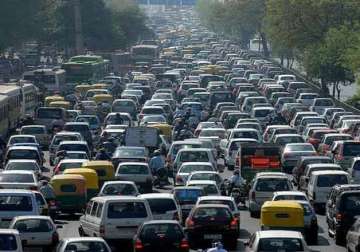New Delhi: The nine million registered vehicles in Delhi is 300 times more than its road network, an overstretched police say, adding drastic solutions are needed to end the nightmare on the capital's roads.
Faulty road designs and rampant indiscipline by motorists are among the major factors that cause massive traffic jams in Delhi, says Sandeep Goel, the joint commissioner in Delhi Traffic Police.
"Road engineering designs are faulty... Six-lane roads convert suddenly into four-lanes at many places, resulting in bottlenecks. And people don't follow the lane system and take shortcuts, creating more problems," Goel told IANS in an interview.
The 90 lakh (nine million) registered vehicles exclude the thousands of vehicles which pass through Delhi every day, from Rajasthan, Haryana and Uttar Pradesh in particular.
On top of it all, Delhi Traffic Police has just 5,000 personnel and is overworked. This works out to just one policeman for every 2,100 vehicles - a horrendous ratio.
"Delhi's road length is 33,000 km. Its vehicle population is much bigger compared to its road network which creates massive traffic jams. The roads get choked at peak hours," Goel says.
And every day, some 1,400 new vehicles are registered in Delhi.
Delhi recorded 8,623 road accidents in 2014, up from 7,566 in 2013. Deaths on roads fell marginally from 1,778 in 2013 to 1,629 in 2014. This works out to four fatalities on roads daily.
Goel says the flow of vehicles in some directions during peak hours often led to choking bumper-to-bumper traffic, triggering frustration, road rage and more.
"If any obstruction comes up, it creates more jams," the officer says, citing wrong parking and vehicle breakdown, particularly of the heavy low floor Delhi Transport Corp (DTC) buses, as two major issues.
"If a DTC bus breaks down, it affects the entire traffic because it can't be towed away in the normal sense due to its bulk and a vacuum system that locks its wheels," Goel tells IANS.
And mechanics generally take 15-20 minutes to reach the spot.
"In that condition, people become so impatient that they take wrong turns on roads because they are not law abiding," he says, how problems compound on Delhi's roads.
"If people follow traffic rules, the problem would not be so big."
Besides the lack of lane discipline, Goel blames faulty road designs. Public transport, particularly auto-rickshaws, cycle rickshaws and Grameen Seva taxis, end up clogging virtually all Delhi Metro stations.
Are there solutions to the crisis on Delhi's roads?
He says new road designs have been formulated and several other steps have been taken. "It's a continuous process."
The traffic police shares the problems with civic agencies.
Like many experts, the officer says trucks coming into Delhi from other states are one of the key reasons for city's pollution and traffic jams.
"At night, trucks would speed up and do haphazard driving. For three to four months we tried to discipline them by deploying more men at night."
The traffic police issues challans to around 40,000 trucks at night this year. But Delhi's traffic woes refuse to go away.
(IANS)
Latest India News
